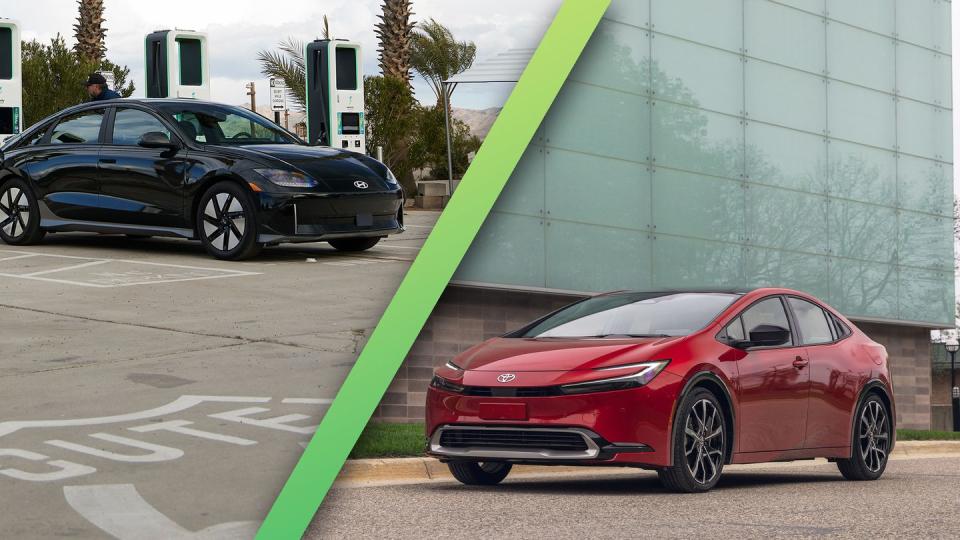Electric vs. Hybrid Cars: Pros and Cons of Each

The march toward electrifying all the vehicular things gives consumers lots of options but makes selecting the best one for them a bit more complex. Where a buyer may have once decided between a smaller, more efficient engine and a big, powerful one within a model line, now there’s the added consideration of batteries, charge ports, and electric motors.
Two such electrified options—EVs and hybrid vehicles—have a lot of overlap but are suited to different uses and buyers. Understanding the differences can help you make the choice that’s best for your needs.
Electric Vehicles Explained
While more and more models see some level of electrification, EVs go all the way, getting their power only from a battery that must be recharged to keep them moving. Sometimes referred to as battery-electric vehicles (BEVs), they have at least one electric motor that drives the wheels to get them down the road.
The main environmental advantage of an EV is their total lack of smog-forming emissions in the local neighborhood in which they operate. In almost all cases they also drastically cut the amount of greenhouse gasses they're responsible for, but that depends on how the electricity they use was generated, which can range from renewable hydroelectric, wind, and solar to a messier coal-fired plant. Crucially, when such "stationary sources" of electricity are modernized and upgraded, every EV downstream effectively gets cleaner. On the technical side, an EV has fewer moving parts compared to a car with an internal-combustion engine, and it provides instant torque that results in brisk (and often addictive) acceleration. They're also quieter and smoother, and give off a premium vibe as a result.
That said, batteries are heavy, and a larger, longer-range battery increases weight further, making long-range EVs and electric trucks comparatively tough on roads (which they don't currently support with gas taxes), while they tend to be expensive to repair in the event of an issue with the pack. This is mostly a future consideration for those that purchase a used EV, because a new EV's high-voltage battery packs is covered for at least 8 years or 100,000 miles, with some makers stretching that out to 10 years and more miles.
There’s also the environmental impact of the battery itself to consider, as many of the ingredients that go into these big packs involve not-so-earth-friendly mining activity, but these impacts are lessening as battery technology improves.
The Advantages of Hybridization
Hybrids are sometimes thought of as the best of both worlds when it comes to efficiency, packaging an internal-combustion engine with one or more electric motors that can generate electricity when hooked to the engine, recapture energy through regenerative braking, and power the wheels with or without help from that engine. The vehicle decides which combination of power sources is best for the current conditions, so you may sense a transition from engine to motor or back again.
But the combination of an internal-combustion engine and at least one electric motor makes for a complex powertrain. Most hybrids rely on a gas engine to power the wheels in most circumstances, with the electric motor(s) there to provide some electric-only motoring and augment the engine by adding power or letting it run at a more efficient speed.
Compared to EVs, hybrids have smaller batteries that store only enough energy to assist the internal-combustion portion of the powertrain for short stints, so the environmental impact of their manufacture is comparatively lower, yet they still rely on fossil fuels. There are variations on that theme, chief among them the plug-in hybrid (PHEV), which adds a charge port and swaps in a larger battery for extended electric-only driving between gas-station visits. (For more on the differences, read our hybrid vs. plug-in-hybrid explainer.)
Deciding between an EV and a Hybrid
Hybrids, especially the plug-in sort, are a great transitional option for those interested in but not yet sold on the EV life. A plug-in lets you dabble in recharging, both at home and on the go, still carrying along that internal-combustion safety net for longer journeys or times when you just can’t find somewhere to plug in. If you live in an apartment or are in the early stages of your career, a "traditional" hybrid that does not plug in will give you the flexibility you may need while still being cleaner and more efficient than a normal car.
When you’re ready to go electric-only, the expanding array of available EVs provides efficiency-minded and performance-oriented options as well as some that do double duty. Choice can be overwhelming, but there’s something for everyone in the electrified future of the automobile.
You Might Also Like

 Yahoo Finance
Yahoo Finance 